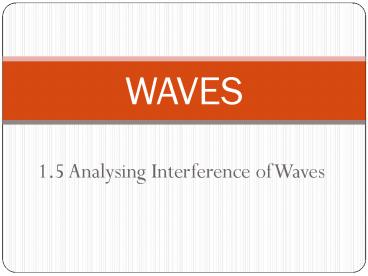1.5 Analysing Interference of Waves PowerPoint PPT Presentation
Title: 1.5 Analysing Interference of Waves
1
WAVES
- 1.5 Analysing Interference of Waves
2
LEARNING OUTCOMES
- At the end of the lesson, student is able to
- State the principle of superposition
- Explain the interference o waves
- Draw and interpret interference patterns
- Solve problems using
3
- Principle of superposition
- When two or more waves pass through each other,
the net displacement at a given point is equal to
the vector sum of the displacement of the
individual waves.
4
- Interference is a phenomenon in which waves from
two coherent sources passing the same point
reinforce or cancel each other. - Coherent sources are sources that produce waves
having - The same frequency
- A constant phase difference.
- There are two types of interference, namely
constructive interference and destructive
interference. - Constructive interference occurs when a crest
meets another crest or a trough meets another
trough. - Destructive interference occurs when a crest
meets a trough.
5
(No Transcript)
6
INTERFERENCE OF WATER WAVES
7
- Along line A1, bright spots are found alternating
with dark spots. - At a bright spot, two crests superimpose
constructively to produce a higher crest. - At a dark spot, two trough superimpose
constructively to produce a deeper trough. - Line A1 is called an antinodal line. Constructive
interference occurs along an antinodal line.
8
- Along line N1, uniform colour is observed. The
water is calm along line N1 - Crests superimpose with trough, thus destructive
interference occur. - Line N1 is called an nodal line.
9
- x distance between two successive antinodal
lines(or nodal lines) - a distance between the two coherent sources of
waves - D distance from each source of waves to line PQ
where x is measured
10
EXERCISE
- Two coherant waves are produced in a ripple tank
by dippers that are placed 5.0 cm from each
other. At a distance of 20.0 cm from the dippers,
the separation between adjacent antinodal lines
is 3.0 cm. calculate the wavelength of the waves.
- ANSWER 0.75 cm
11
INTERFERENCE OF SOUND WAVES
12
(No Transcript)
13
- (a) a loud sound is detected at the position
where the sound waves from the loudspeakers
interfere constructively. - (b) a soft sound is detected at the position
where the waves from the loudspeakers interfere
destructively. - For interference of sound waves, the equation is
given also as
14
EXERCISE
- Two loudspeakers connected to an audio signal
generator were placed 1.2 m from each other. A
student who was walking along a line 3.0 m in
front of the loudspeakers could hear alternating
loud and soft sounds, the distance between
adjacent loud and soft sounds is 0.85 m. What is
the wavelength of the sound. - ANSWER 0.68 m
15
INTERFERENCE OF LIGHT WAVES
16
- Interference of light waves can be studied using
Youngs double slit. - When a beam of monochromatic light passes through
the double slit, interference of light produces a
pattern consisting of bright and dark fringes on
the screen.
17
(No Transcript)
18
- The light that passes through each slit is
diffracted. The two diffracted beams of light
superimpose. - (a) at the bright fringe, the light waves from
each slit interfere constructively. - (b) at the dark fringe, the light waves from
each slit interfere destructively. - For interference of sound waves, the equation is
given also as
19
EXERCISE
- The figure below shows the interference pattern
formed by red laser light. - Calculate the value of y.
- ANSWER 8.16 mm

